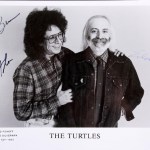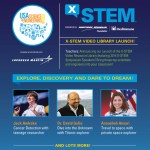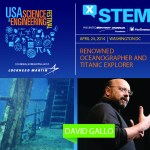Oceanography
Sometimes science sees something change – there is more of something, or less, or more importantly, there is a change in the rate of some phenomenon or in its pattern of variability. But sometimes science looks out there in the world and observes something that was probably there all along (though there may be changes in the past or future) but it just wasn’t noticed before.
There is a new study that describes and documents such a phenomenon. The thing we are talking about is over 100 kilometers across, several meters thick, moves at about 4.5 km/h, exists just below the surface of the ocean…
Teachers- the USASEF Team is thrilled to announce the launch of our video resource library featuring presentations from our 2014 X-STEM Symposium! The 2014 X-STEM Extreme STEM Symposium- presented by Northrop Grumman Foundation and MedImmune- featured interactive presentations and workshops by an exclusive group of visionaries who aimed to empower and inspire elementary through high school students about careers in science, technology, engineering and mathematics (STEM). Now, you can bring these STEM Professionals into your classroom with our FREE library of 15-…
On April 24, 2014, an exclusive group of visionaries presented to over 4,000 students at the USA Science & Engineering Festival's inaugural X-STEM Symposium sponsored by Northrop Grumman Foundation and MedImmune. The all day event included interactive presentations and workshops with some of the top scientists and engineers in the country.
In the presentation below, renowned oceanographer Dr. David Gallo dives into the unknown world deep under the sea to discuss ocean exploration, unexplored creatures and territory and the technology required to make it…
X-STEM - presented by Northrop Grumman Foundation and MedImmune - is an Extreme STEM symposium for elementary through high school students featuring interactive presentations by an exclusive group of visionaries who aim to empower and inspire kids about careers in science, technology, engineering and mathematics (STEM). These top STEM role models and industry leaders are sure to ignite your students’ curiosity through storytelling and live demonstrations.
Our spotlight on our X-STEM Speakers continues with Titanic Explorer Dr. David Gallo!
The world deep…
tags: Project Kaisei, Oceanography, North Pacific Gyre, North Pacific Garbage Patch, plastic, pollution, environment, streaming video
Underwater videographer, underwater photographer, and author, Annie Crawley joined Scripps Institute of Oceanography and Project Kaisei aboard the New Horizon on a 3 week long expedition to the North Pacific Gyre. They collected data to help find a solution to the "Plastic Vortex" forming in our Ocean.
tags: Project Kaisei, Oceanography, North Pacific Gyre, North Pacific Garbage Patch, plastic, pollution, environment, streaming video
Project Kaisei's 2009 Expedition. Footage from the Kaisei, one of two research vessels Project Kaisei sent to the North Pacific Gyre in August, 2009 to study the extent of the marine debris problem in the gyre, the impact it may be having on marine life and the food chain, and to find ways to catch and recover some of the debris for a larger clean-up effort.
tags: plastics, oceanography, pollution, environnment, streaming video
This is a message by Captain Charles Moore, an oceanographer who pioneered the study of plastic debris, and was recorded during the Strategic Council on Plastic Pollution convened at the Google Campus in Mountain View, California on June 4, 2009. It was the first meeting for the council on plastic pollution, which was recently formed to raise awareness of this rising threat to the world's oceans. Council member and marine biologist Dr. Wallace J. Nichols, noted that "we are finding plastic in the stomachs of sea turtles,…
tags: garbage patch, Pacific Ocean, environment, science, Scripps Institute, streaming video
Scripps scientist Miriam Goldstein talks about the SEAPLEX expedition to the North Pacific Gyre and how shocked she was to find the amount of plastic on the ocean's surface when floating around in a skiff.
In support of our on-going DonorsChoose challenge, this month Minnow and I will be exploring science-related books for SciWo's storytime.
I have to admit, I'm enjoying the challenge of finding sciencey books appropriate for a 2.5 year old's attention span. There seem to be a plethora of books for the 4-8 year old set, but fewer for the younger crowd. Well, that's not true. There are an awful lot of books about animals, especially farm animals, but Minnow has got her animals down pat, and we all know there is more to science than zoology.
I'm also discovering that it is easier to keep Minnow…
Guest post from Female Seaside Scientist, for the Diversity in Science Carnival!
Dr. Cindy Lee Van Dover is a Professor of Marine Biology, Director of the Duke University Marine Lab, and Chair of the Marine Science and Conservation Division at the Nicholas School. Her research combines biogeochemistry, biodiversity, ecology of chemosynthetic deep-sea vent organisms, marine technology, and astrobiology.
Faculty page here; research page here; cv here.
More after the jump
Professor Van Dover had an early fascination with Jules Verne's Captain Nemo character from the "20,000 Leagues under…
tags: nature, oceanography, marine life, sardines, South Africa, streaming video
I watched this film a couple days ago when I visited the AMNH, and then a reader and friend found this video on youtube -- so of course, I had to share it with you! [3:33]
While Wild Ocean explores the causes and effects of man's impact, it an inspirational film looking toward a bright future, taking audiences to a rare unspoiled marine wilderness to glimpse what the oceans of the world once looked like. The film champions the creation of marine reserves necessary to bring our oceans back to life. South Africa…
William J. Broad's Times piece on the new National Geographic "Ocean - An Illustrated Atlas gives a nice look at both the book -- and gives long-overdue and well-deserved attention to oceanographer Sylvia Earle, who co-authored the Atlas.
. Earle's passion extends to the far horizon. In the atlas, she reports that some 90 percent of deep-sea creatures use bioluminescence in their life strategies and that the eerie glows may turn out to constitute the planet's most common form of communication.
tags: environment, commercial fishing industry, bottom trawling, orange roughy, Chilean sea bass, seafood
Landsat satellite image, Gulf of Mexico (mouth of Vermillion Bay, Louisiana), taken on 10/12/92. Note the abundant narrow sediment trails, most in shallow water (20m), possibly caused by trawling.
Image: SkyTruth [larger view].
Ain't technology grand? Thanks to Landsat satellite images, which are available on the internet, the ordinary citizen can now see what is happening to our planet -- but sadly, much of it is not good. For example, the above image of the Gulf of Mexico was taken…


